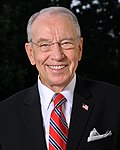Current delegation
| Current U.S. senators from Iowa | ||||
|---|---|---|---|---|
Iowa
| Class II senator | Class III senator | ||
 Joni Ernst (Junior senator) (Red Oak) |  Chuck Grassley (Senior senator) (New Hartford) | |||
| Party | Republican | Republican | ||
| Incumbent since | January 3, 2015 | January 3, 1981 | ||
Iowa's current congressional delegation in the 119th Congress consists of its two senators and four representatives, all Republicans.
The current dean of the Iowa delegation is Senator and President pro tempore of the United States Senate Chuck Grassley, having served in the Senate since 1981 and in Congress since 1975.
| Current U.S. representatives from Iowa | |||||
|---|---|---|---|---|---|
| District | Member (Residence) [3] | Party | Incumbent since | CPVI (2025) [4] | District map |
| 1st |  Mariannette Miller-Meeks (Davenport) | Republican | January 3, 2021 | R+4 |  |
| 2nd |  Ashley Hinson (Marion) | Republican | January 3, 2021 | R+4 |  |
| 3rd |  Zach Nunn (Bondurant) | Republican | January 3, 2023 | R+2 |  |
| 4th |  Randy Feenstra (Hull) | Republican | January 3, 2021 | R+15 |  |